
This website uses the Post Office term “roll” rather than the philatelic term “coil”, but “coil join” is commonly used to describe a pair of stamps which show the join between two strips using part of a sheet margin. Joins also occur between the leader and the first stamp, and between the last stamp and the tail.
Leader to Stamp Joins
The method of joining the leader to the first stamp varies with the type of roll. Clearly Lower End delivery leaders are joined to the bottom of the stamp, Top End to the top, and Left Side to the left, but there are different techniques used to make the join.
Vended rolls have stamps facing inwards, so the back of the stamp is joined to the back of the leader, gum to gum. Some vended rolls were made from strips, and on these the sheet margin is attached to the leader, but most were continuously printed and the stamp is attached directly to the leader. The first vended rolls (Kermode) were top end delivery, hence the join was to the top of the stamp, but this was changed to lower end delivery in 1927, and remained so:
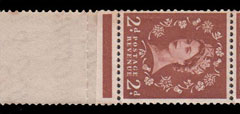
Strip
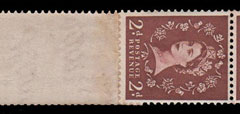
Continuous
Endways affixer rolls (POKO and FIXO) have stamps facing outwards, so the back of the stamp is joined to the front of the leader. For strips from sheets, the sheet margin is gummed on top of the leader, or if the leader is gummed, the leader can be gummed on top of the margin. For continuously printed stamps, the stamp is attached directly to the leader:

Leader on top
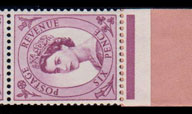
Margin on top
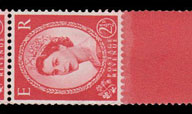
Continuous
Sideways affixer rolls (Multipost) have stamps facing outwards, so the back of the stamp is joined to the front of the leader. For strips from sheets, the sheet margin is gummed on top of the leader, or if the leader is gummed, the leader can be gummed on top of the margin. For continuously printed stamps, the stamp is attached directly to the leader:
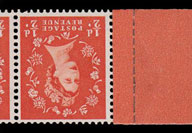
Leader on top

Margin on top

Continuous
For both endways and sideways strips from sheets, starting with Downey Head rolls, the majority have the sheet margin gummed on top of the leader. This changed over time and for Photogravure rolls it was the other way around with the leader gummed on top of the margin. This remained consistent through King George VI rolls to the Tudor Crown rolls but was changed back in 1955 for St. Edward’s Crown rolls. The ½d and 6d “leader on top” joins above left are therefore Tudor Crown, the ½d and 6d “margin on top” in the middle are not (St. Edward’s Crown and Multiple Crowns).
Stamp to Stamp Joins
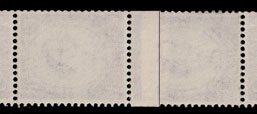
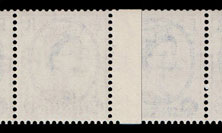
There are fewer variations of joins between stamps as they only occur in rolls made from sheets (obviously continuously printed stamps do not need to be joined). Endways rolls can be joined using the top or bottom margins (bottom margin illustrated), and sideways rolls can be joined using the left or right margins (left margin illustrated — on the right when viewed from the back).
There was not much consistency in the choice of margins, sometimes different margins were used within the same roll, but endways rolls used the bottom margin more often than the top. Sideways rolls generally used the left margin up to 1955, then switched to the right margin. It has been suggested that the change was made either to avoid cylinder numbers (which would create a philatelic item), or to avoid snagging in the machinery.
Stamp to Tail Joins
The method of joining the last stamp to the tail is similar to the first stamp to the leader, but flipped with Lower End delivery tails joined to the top of the stamp, Top End to the bottom, and Left Side to the right. The techniques are also similar to the leaders above, but with the join flipped to the other side. This tail shows a diagonal cut in the stamp margin:

½V Cuts
Diagonal cuts across the corner of booklet panes are well known to collectors. The Bookmark Catalogue says “A slanting cut was made with a pair of scissors in order to provide an exit for tearing off the bottom margin and to prevent the tear inadvertently removing the trimmed binding margin”. The perforations adjacent to the cut are thus torn and not guillotined.
It’s less well known that these ½V cuts also appear in rolls, and from an earlier time than booklets, occurring during the Pale Colours period in the 1940s through to the Crowns issues. The perforations adjacent to these cuts are also torn.
To see the reason for these cuts, the method of creating rolls from sheet stamps must be understood, most importantly that many sheets (or half sheets) of stamps were joined together between sheets of leaders and tails to form large “master” rolls, either 10 or 12 issued rolls wide. The master rolls were later slit into individual rolls. I.e. sheets were joined together first, then slit and reeled into issue sized rolls. This reconstruction shows the first half sheet joined to an uncut sheet of 12 sideways leaders:
Click the image to enlarge.
To form sideways rolls, sheets of 12×20 stamps were divided to make two half sheets of 12×10. Some of the ½V cuts (less than half) show parts of marginal arrows, suggesting that the cuts were made to divide the sheet in half as well as to remove the top and bottom margins. 40 such half sheets were needed to make rolls of 480 stamps. Roll 1 has the cut at the top of the leader (bottom of the stamp), and roll 10 has the cut at the bottom of the leader (top of the stamp).
To form endways rolls, sheets of 12×20 stamps were used without being divided. The cuts were made to remove the left and right margins. 48 sheets were needed to make rolls of 960 stamps. Roll 1 has the cut at the top of the leader, and roll 12 has the cut at the bottom of the leader. The position of the cut on the stamp varies with the type of roll: vended, affixer lower end first, or affixer top end first.
| Leader | Coil Join | Tail | |
|---|---|---|---|
| Pale Colours | (S) | 1½d | — |
| New Colours | (P) | ½d, 4d | — |
| Tudor Crown | (P), (S) | ½d, 1d, 3d | — |
| St. Edward’s Crown | (O), (S) | 1d | — |
| Graphite | (N), (T), (M), (S) | 2d, 2½d, 3d | (T) |
| Crowns | (O), (P) | 4d | — |
| Leader | Coil Join | Tail | |
|---|---|---|---|
| Dark Colours | — | 6d * | — |
| Pale Colours | (C) | — | — |
* although this 6d join is listed under Dark Colours, the stamp was not changed during the Pale and New Colours periods, so this join was probably made later in the reign.
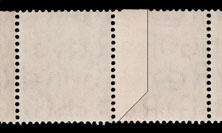
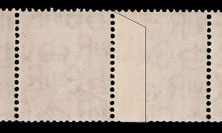
Typical ½V coil joins on King George VI stamps using left margins.
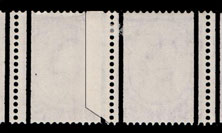

Typical ½V coil joins on graphite lined stamps using right margins.
½V cuts are fairly common on the graphite lined issues. Since graphite lines were applied continuously, they could only run in the direction of the watermark. Hence there are no continuously printed graphite rolls with sideways watermark, all sideways delivery graphite rolls are made of strips from sheets, and so relatively more common.

